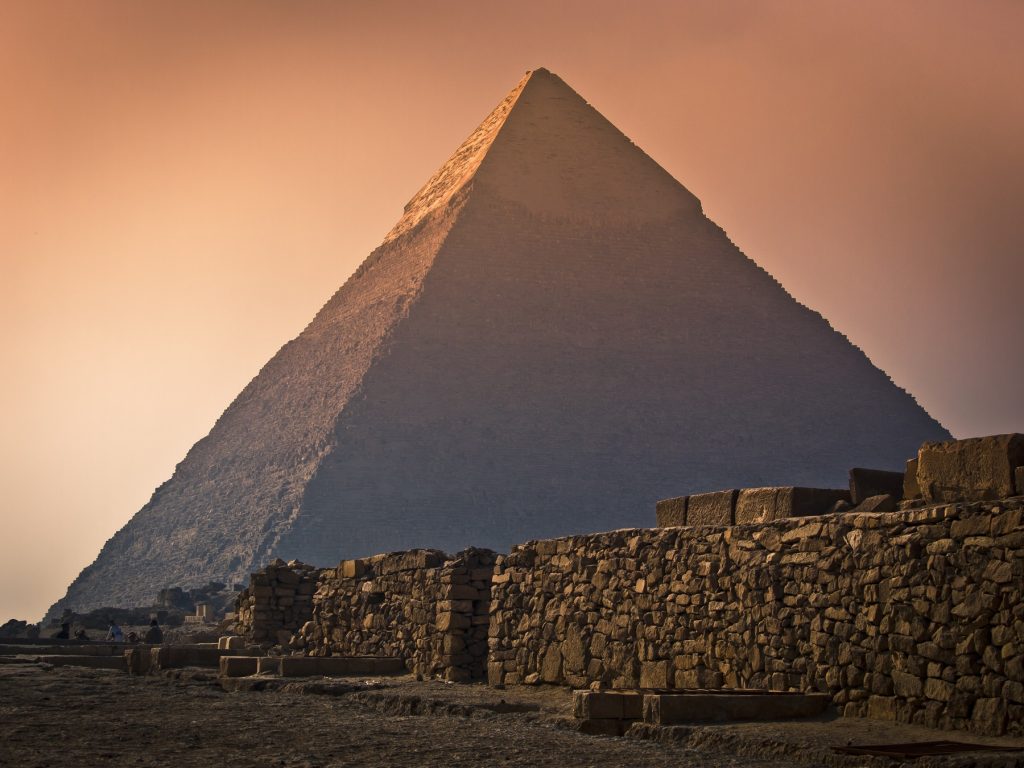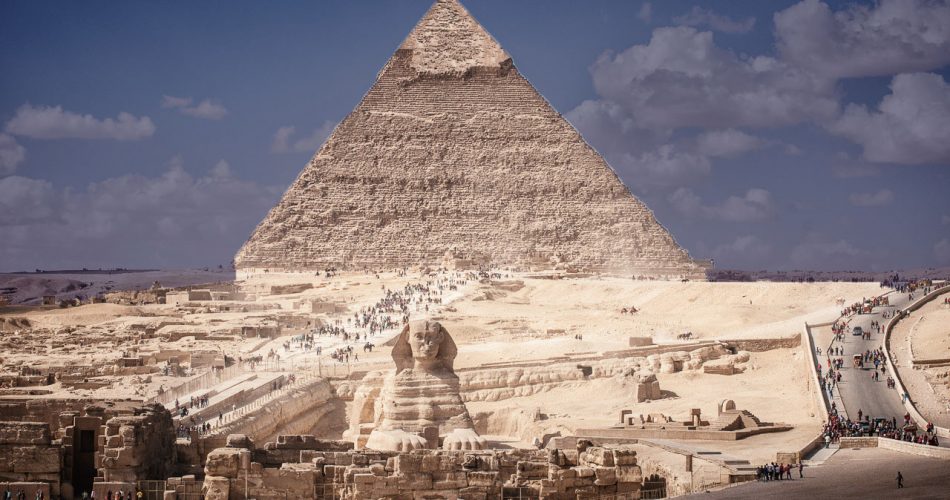The Pyramid of Khafre is often mistakenly portrayed in images and videos as the Great Pyramid of Giza. This is because, in most of these images, the pyramid appears the largest of the three at the Giza plateau. However, despite the fact that an optical illusion may make us think it is the largest of the three, it is nowhere near as big as the Great Pyramid.
Its very easy to discern the Great Pyramid—of Khufu—and the Pyramid of Khafre. The Great Pyramid of Giza stands at 138.8 meters (455 ft) (contemporary), while Khafrer’s pyramid 136.4 meters (448 ft). This height difference may not be visible immediately since both pyramids are massive. However, the Pyramid of Khare maintains most of its casing stones at its summit. The Great Pyramid of Giza, on the other hand, has a flat space where its pyramidion is once believed to have stood.
An almost Great Pyramid
Believed to have been constructed in the Fourth Dynasty reign of King Khafre, the Pyramid has a base length of 215 meters (706 ft) and rises up to a height of 136.4 meters (448 ft). Built nearly to the same size as the Great Pyramid of Giza, Khafre’s Pyramid was constructed with similar, supermassive blocks of stone, some of which weigh more than 5 tons. Steeper than Khufu’s pyramid, Khafre’s ancient monument was built with an angle of 51°. But the reason why the pyramid appears larger than Khufu’s pyramid is because Khafre’s was constructed on bedrock that has an elevation of 10 meters higher than Khufu’s. It’s because of this “hill” at Giza why many people think Khafre’s pyramid is, in fact, the Great Pyramid of Giza.
When completed, around 2,570 BC, the pyramid was covered by polished white Tura limestone and rose to a height of 143.5 meters or 471 ft. It is the second-largest pyramid of Egypt and has a total volume of 2,211,096 cubic meters (78,084,118 cu ft). Although casing stones cover the uppermost part of the pyramid, its pyramid and apex are missing, just as those of the Great Pyramid.
Archeologists have found that the bottom casing stones were made of prink granite while the remaining parts of the pyramid were covered in Tura limestone which originated from quarries on the other side of the Nile river.
Khafre’s pyramid may have been less “perfect” compared to the Great Pyramid of Giza. Close examination of the structure reveals that the pyramid’s corner edges of remaining casing stones were not completely straight and are staggered by a few millimeters. This may have been in part due to seismic activity although another theory suggests that the slope of the stone was cut to shape before being placed as the workers were left with fewer working space towards the top of the pyramid.

In addition to the bottom course of outer casing stones in granite, the pyramid of Khafre was cased with Tura limestone. As mentioned earlier, only its uppermost parts remain. This is, according to Lehner, because the robbers first stripped the lower corners of the pyramid from its casing stones, working their way upwards. Just below the lowest surviving course of casing stones, a series of regular stepped core stone is visible. The remainder of the pyramid—from the base downwards—is made out of rough, irregular and loose stones.
The exact reason behind this discrepancy remains unexplained. Is it packing between core and casing, exposed when the casing stones were torn away from the corner of the pyramid?
As Lehner reveals, this may seem likely until, climbing the corners of the pyramid, one sees that this irregular masonry seems to continue for some depth into the very center of the pyramid.
This discontinuity may signalize a different building style, or even a stall and resumption of construction. Additionally, the core masonry may have been laid in a more regular fashion towards the top of the pyramid, in order to allow the builders more control.
Interior
The inside of Khafre’s pyramid is different from that of the Great Pyramid of Giza. Surveys of the pyramid suggest there are two entrances that lead towards the room that Egyptologists say was the Pharaoh’s burial chamber. One entrance opens 11.54 m (38 ft) up the face of the pyramid and one that opens at the base of the pyramid. Measurements of the pyramid revealed that these passageways are not centered within the pyramid, but are offset towards the east at around 12 m (39 ft).
Similar to the Great Pyramid’s subterranean chamber, Khafre’s pyramid has one room that was carved completely out of the bedrock: It is a descending passage that runs horizontally before it ascends and joins the horizontal passage leading into the pyramids main chamber.
The exact reason why two entrances were built into the pyramid eludes experts. However, one theory suggests that the pyramid was planned as a much larger structure. Scholars believe that Khafre wanted to build a pyramid that was much larger than that of his father. Curiously, it is believed that the Great Pyramid of Giza was initially designed to be a much smaller structure. However, during construction, the pyramid was enlarged on several occasions until it was of satisfactory size.
There is a subsidiary chamber that opens to the west of the lower passage in Khare’s pyramid, equal in length to the king’s chamber of the Great Pyramid. Its exact purpose remains an archaeological mystery.
You would expect that Khafre, who obviously tried mimicking his father’s pyramid, would also try to replicate its interior. However, the Pyramid of Khafre is different from Khufu’s pyramid. For one, it doesn’t have as many chambers as the Great Pyramid of Giza (or at least we haven’t found them yet) and second; it does not have ascending and descending passages like the pyramid of Khufu. But this may not come as such a big surprise since if we look back at the history of pyramid building in Egypt, we will notice that not one pyramid was replicated in the exact way as the earlier. Had this been the case, we would have seen many more Step Pyramids like that of Djoser.
Getting back to Khafre’s pyramid. Egyptologists have explained that the pyramid’s burial chamber was carved out of a pit in the bedrock. Its was built of gabled limestone beams, and the chamber takes a rectangular shape, oriented east to west. The alleged burial chamber and the sarcophagus were found without the body of the King. When the pyramid was entered by Belzoni, he found only the bones of an animal, possibly a bull, and no traces of King Khafre anywhere in the pyramid.

